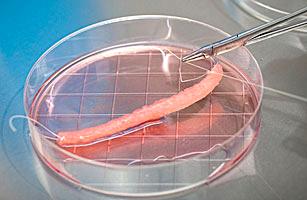If you walk up to the fourth floor of the Hunt Library, you will find the future of medicine nestled away in a small closet. No, it’s not a fancy operating room or an MRI machine. It’s a 3-D printer.
3-D printers are used to create three-dimensional solid objects from digital models using engineering or design programs such as SolidWorks. Operators do this through an “additive process,” in which successive layers of a certain material, such as plastic, are placed on top of one another until the desired three-dimensional object is fully formed. Smartphone cases, jewelry and battery-powered motors are just a few of the things that have been created using this state-of-the-art technology.
However, medical researchers around the world are now developing a way to use these printers to create organs using human stem cells — cells that are undifferentiated and have the ability to become almost any type of cell.
Instead of using plastic as the printers in Hunt Library do, these 3-D printers have the ability to ooze out successive layers of human embryonic stem cells to create organs. Organs that previously had to be donated could potentially be created at the press of a button, ushering in a new era of regenerative medicine.
This past February, a team of researchers in Scotland announced that they had solved perhaps one of the biggest obstacles facing the production of human organs using 3-D printers. These researchers successfully printed out stem cells without compromising their functionality or viability — a crucial first step.
“We are able to print millions of cells within minutes,” Will Shu, a researcher at Hariot-Watt University in Edinburgh, said in an interview with Agence France-Presse.
This opens the door to the possibility of transplanting a 3-D printed trachea into a patient with late-stage tracheal cancer.
Researchers are optimistic about this because the trachea is one of the organs that has already been artificially created using human stem cells, without 3-D printing technology, and successfully transplanted into patients.
By using 3-D printing, the process could become quicker and more efficient — allowing more patients to be treated with regenerated organs.
According to the United States Department of Health and Human Services, there are now more than 105,000 people on the waiting list for solid organ transplants. The Department also has reported that 18 people die every day waiting for a transplant because of the critical shortage of donated organs.
In the long-term, 3-D organ printing can save the lives of several thousand patients, getting them off transplant lists by eliminating the need to wait for a donor, especially for the most easily printable organs.
Michelle Borges, a senior in biochemistry, said she is excited about the new advancement in medical technology.
“If this process can get people off of transplant lists then I think it’s a great avenue to explore,” Borges said.
Others, however, see the use of human embryonic stem cells as a moral dilemma and oppose it.
“It’s great that researchers are finding new ways to save lives and I’m all for it, but not at the expense of harming God-given life,” Muneeb Mustafa, a senior in supply-chain management, said.
Researchers also hope to use this technology to create organs for the use of animal-free drug testing, which has been a hot topic issue for the past several years.
Jason King, who was involved with the project at the British stem cell company Roslin Cellab, said in an interview with Agence France-Presse that he is optimistic about the future of more ethical drug testing.
“This is a scientific development which we hope and believe will have immense valuable long-term implications for reliable, animal-free drug testing,” King said.
The NCSU College of Veterinary Medicine and Wake Forest’s Institute for Regenerative Medicine are partnering in producing regenerated organs, and are using this new technology to advance this new field of medicine.








